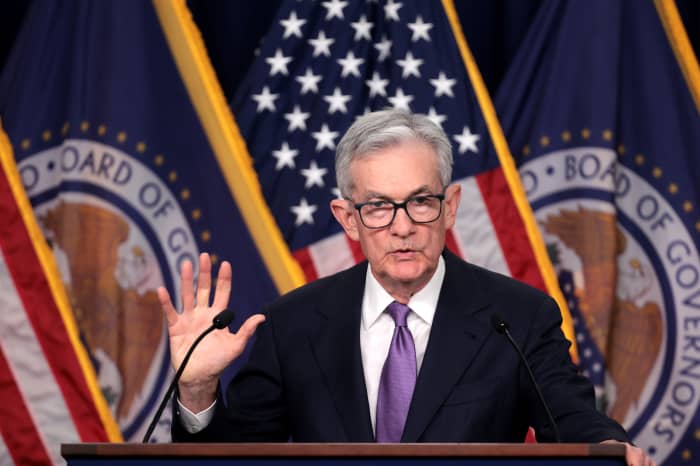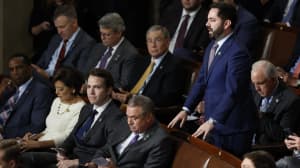The biggest question going into the Federal Reserve’s policy meeting next week is what sort of smoke signals Fed Chair Jerome Powell will send about the possibility of an interest rate cut at the central bank’s next meeting in March.
Fed officials are not expected to make any changes to rates at the Jan. 30-31 meeting, but will use the discussion to get their ducks in a row for future monetary easing, economists said.
Fed watchers agree that Powell will leave the door open for a move as soon as March but officials won’t decide one way or the other because that meeting is two months away.
Right now, markets are pricing in a roughly 50-50 chance of a cut in March.
“If I were in his shoes, I’d be trying to get out of the press conference leaving things probably mostly undisturbed. A 50-50 chance on a March rate cut…looks fine to me,” said David Wilcox, a former top Fed staffer and now a senior fellow at the Peterson Institute for International Economics and economist at Bloomberg Economics.
With even odds on the Fed’s next move, the Fed could the go either way, depending on the data, Wilcox said.
Matthew Luzzetti, chief U.S. economist for Deutsche Bank, said the Fed will clear the way for the first rate cut in this cycle by removing language from its statement that suggested the next move would be a hike.
That essentially brings to an end the tightening cycle that began in March 2022 after the burst of inflation over the prior year. Since then, the central bank pushed its benchmark rate up from close to zero to a range of 5.25%-5.5%.
Given the recent U.S. data, Powell will be able to put a positive spin on the outlook and talk about the chances of continued economic growth with lower inflation and the long-sought-after soft landing.
Hard questions for the Fed: Pace of rate cuts and when will they end
Wilcox said the Fed has a clear reason to cut rates – high rates are no longer needed given the progress made on bringing inflation down since last summer.
Core inflation is now running at a 2.9% annual rate, the lowest rate since March 2021.
“The fight to bring inflation back down to 2% has been almost won and maybe completely won,” Wilcox said.
Another reason to bring down rate is the Fed doesn’t want financial conditions so tight to needlessly risk provoking a recession.
“They want to avoid putting the economy through a recession that it doesn’t need for the sake of inflation control,” he said.
The harder questions are the pace of the rate cuts and where to stop, Wilcox said.
Wilcox said he expects the first rate cut in March and a total of six quarter-point reductions this year.
Michael Gapen, chief U.S. economist at BofA Securities sees four quarter-point rate cuts beginning in March.
“We are in the early but gradual camp,” Gapen said. Gapen thinks the Fed will stop when interest rates are down to 3% but that is an open debate that doesn’t need immediate answer.
Luzzetti of Deutsche Bank said he expects the Fed to wait until June to start cutting, with 175 basis points in reductions over the rest of the year. That’s based on a mild recession that is in his forecast.
Carl Riccadonna, chief U.S. economist at BNP Paribas, thinks the Fed will hold off until May and there is a risk of further delay.
“We expect officials will err on the side of patience before an initial rate cut, he said. The strong growth rate in the fourth quarter and higher consumer sentiment suggests it may be a “bumpier-than-expected” path for inflation to register 2% over time, he said.
At his press conference next week, Powell is likely to echo comments from Fed Governor Christopher Waller, who said rate cuts “can and should be lowered methodically and carefully.” The Fed has often eased more quickly in the past but that was when shocks to the economy have threatened or caused a recession, Waller noted.
Any changes to quantitative tightening program?
Economists are also focused on what the Fed will say about its policy to shrink its balance sheet, which swelled to $9 billion at its peak from $4.2 trillion in 2019.
The Fed has been allowing roughly $76 billion per month in maturing securities to roll off its balance sheet, according to Chris Low, chief economist at FHN Financial.
After the Fed’s December meeting, officials began to discuss the possibility of slowing the roll off. Economists now expect more details after next week’s meeting.
A slower roll-off pace implies the Fed will need to buy more Treasuries, which is a dovish message for the market, Low said.
Marc Giannoni, head of U.S. research at Barclays, thinks any decision on the balance sheet is not imminent.
“We think this suggests that Fed staff will present material to the FOMC at one of the upcoming meetings and that FOMC participants will discuss the material, but we expect an announcement about the tapering and end of QT to take place at a later meeting,” Giannoni said, in a note to clients.







